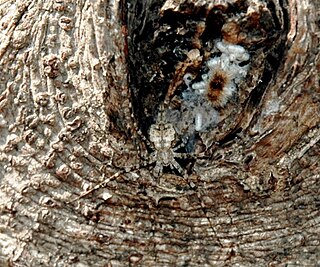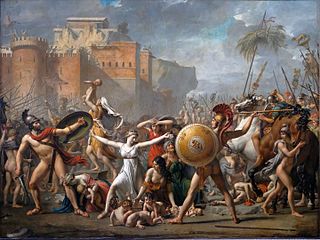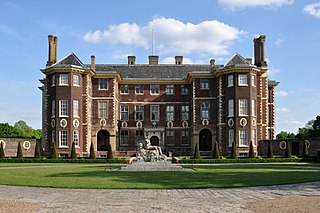Related Research Articles

In Roman mythology, Hersilia was a figure in the foundation myth of Rome. She is credited with ending the war between Rome and the Sabines.

In Greek mythology, Iris is the personification and goddess of the rainbow and messenger of the gods.
Hersilia is a fairly large Main belt asteroid. It was discovered by C. H. F. Peters on October 13, 1879, in Clinton, New York. The asteroid was named after Hersilia, Roman wife of Romulus. It is classified as a primitive, dark carbon-rich C-type asteroid.

Tree trunk spiders (Hersiliidae) is a tropical and semi-tropical family first described by Tamerlan Thorell in 1870. They have two prominent spinnerets that are almost as long as their abdomen, earning them the nickname "two-tailed spiders". They range in size from 10 to 18 millimetres long. Rather than using a web that captures prey directly, they lay a light coating of threads over an area of tree bark and wait for an insect to stray onto the patch. When this happens, they encircle their spinnerets around their prey while casting silk on it. When the insect is immobilized, they can bite it through the shroud.

Rugged Island is an island 3 miles (4.8 km) long and 1 mile (1.6 km) wide, lying west of Livingston Island in the South Shetland Islands. Its surface area is 10.4 square kilometres (4.0 sq mi). The island's summit San Stefano Peak rises to 256 metres (840 ft) above sea level. Rugged Island is located at 62°38′S61°15′W. Rugged Island was known to both American and British sealers as early as 1820, and the name has been well established in international usage for over 100 years.
206 is the natural number following 205 and preceding 207.

Hersilia savignyi is a hersiliid spider found in Kerala, Maharashtra, Gujarat, Telangana, Karnataka, West Bengal, Myanmar, Philippines, Singapore, and Sri Lanka.
Caryatis is a genus of tiger moths in the family Erebidae.

The Intervention of the Sabine Women is a 1799 painting by the French painter Jacques-Louis David, showing a legendary episode following the abduction of the Sabine women by the founding generation of Rome.

Vietor Rock is a rock linked by a spit to Nikopol Point on the south coast of Byers Peninsula, Livingston Island in the South Shetland Islands, Antarctica. The area was visited by early 19th century sealers operating on Byers Peninsula.

Hersilia Cove is the 650 m wide cove indenting for 800 m the north coast of Rugged Island in the South Shetland Islands, Antarctica west of Herring Point.
El Rapto de las Sabinas is a 1962 historical drama film adaptation of the Roman foundation myth about the abduction of Sabine women by the Romans shortly after the foundation of the city of Rome.

Mestra is a genus of nymphalid butterfly. It contains Mestra dorcas, the Jamaican mestra, which is found from southern North America to South America and possibly Mestra cana, the St Lucia mestra, found in the Lesser Antilles.

Caryatis hersilia is a moth of the subfamily Arctiinae. It was described by Herbert Druce in 1887. It is found in Cameroon, Nigeria and South Africa.

Sir Lyonel Felix Carteret Eugene Tollemache, 4th Baronet was an English landowner.
Hersilia tibialis is a species of spider of the genus Hersilia. It is native to India and Sri Lanka.
The Hersilia was an American merchant vessel and the first from the United States to visit the South Shetland Islands. During its second voyage it was seized by Vicente Benavides, a royalist commander in the Chilean War of Independence, who ordered its destruction late in 1821.
Hersilia is a woman that features prominently in myths related to the creation of Rome.
References
| This article related to members of the insect family Tachinidae is a stub. You can help Wikipedia by expanding it. |